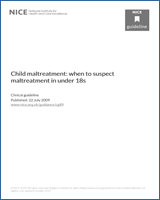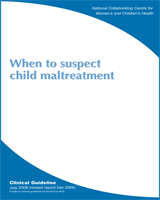- Absolute risk reduction
The difference between the observed rates of an event (i.e. the proportions of individuals with the outcome of interest) in the groups being compared.
- Abandonment
Leaving a child on his or her own without any intention of returning to ensure their safety and wellbeing.
- Affect
Emotion, feeling.
- Apnoea
A period when there is no external breathing.
- Apparent life-threatening event
A sudden event characterised by a combination of apnoea, colour change, marked change in muscle tone and choking or gagging.
- Body mass index
A person's weight (in kilograms) divided by the square of their height (in metres). It is used to determine whether a person is underweight, overweight or obese.
- Cognition
Thinking, believing, knowing.
- Craniocerebral
Related to the skull and the brain.
- Cyanosis
An appearance of blueness in skin and mucous membranes due to a lack of oxygen or fall in arterial oxygen saturation.
- Dental caries
Tooth decay.
- Dysuria
Pain on passing urine.
- Ecchymosis
A type of bruise that looks bluish-black and which is caused by the leaking of blood into tissues as a result of injury or blood disorder.
- Emotional dysregulation
The inability to regulate emotions such that reactions to situations are out of proportion to or inappropriate for the situation causing the reaction.
- Erythema
Redness of the skin.
- Externalising
Behaviours that represent interpersonal conflict such as aggression, oppositional behaviour and other antisocial behaviour.
- Failure to thrive
When a child's growth falls through two or more centile spaces on standard growth charts.
- Femoral
Of the femur, the thigh bone.
- Gaping, anal gaping
An anus that is open (dilated) on separation of the buttocks such that a view into the anal canal or rectum is possible, and which remains so for the duration of the examination in a fixed or constant way. This is a static sign.
- Genital mycoplasmas
A bacterial sexually transmitted infection.
- Gingival
Of the gums.
- Hymenal laceration
A fresh wound made by tearing through the hymen which may be partial or complete.
- Hymenal notch
An identation in the hymen not extending to its base.
- Hymenal transection
A discontinuity in the hymenal membrane that extends through the width of the hymen to its base so that there appears to be no hymenal tissue remaining at that location. The term is used to describe healed appearances.
- Hypernatraemia
An elevated level of sodium on biochemical blood test.
- Hyperphagic
Excessive eating.
- Hypoxic ischeamia
Damage to the brain due to lack of blood and oxygen supply.
- Internalising
Describes a number of internal stresses such as anxiety and depression.
- Labial frenum
The small piece of tissue that connects the lips to the gums.
- Laceration
A tear in the flesh.
- Metaphyseal
A fracture to the portion of bone between the shaft (diaphysis) of a long bone and the epiphysis or growing point at either end of the bone.
- Mucosal laceration
A cut to the mucosa, which is the cellular lining of the alimentary canal from mouth to anus and the male and femal genital areas.
- Near-drowning
Survival after suffocation caused by a (potentially fatal) submersion in water/fluid.
- Neurological sequelae
Consequences that manifest as neurological symptoms or signs, for example impaired consciousness, fits and nerve damage.
- Normative
Normal/usual.
- Oedema
Excessive accumulation of fluid in the body tissues.
- Oppositional defiant disorder
A psychiatric disorder where a child is excessively defiant and hostile towards figures of authority.
- Osteogenesis imperfecta
A congenital disorder in which the bones are unusually fragile and brittle.
- Osteopenia of prematurity
Brittle or weak bones in preterm infants.
- Petechiae
Minute haemorhages into the skin giving an appearance of clusters of tiny red dots.
- Posterior fourchette/fossa
The anatomical area of the female genitalia at the base of the vagina where the labia minora (thin folds of tissue on either side of the vaginal opening) join. It lies between the vaginal opening and the anus.
- Post-traumatic stress disorder
An anxiety disorder that arises after exposure to one or more extreme stressors.
- Reflex anal dilatation
The dynamic action of the opening of the anus due to relaxation of the external and internal sphincter muscles with minimal buttock traction.
- Somatic
Relates to the body (as distinguished from the mind).
- Subconjunctival
Anatomical part of the eye below the conjunctiva, which is a clear membrane (thin layer) that covers the white of the eye.
- Supracondylar
Portion of the bone, namely humerus above the condyle or articular lower portion of the bone (elbow).
- Trichomonas vaginalis
A single-cell anaerobic protozoan that causes trichomoniasis, which is a sexually transmitted infection.
- Visceral injury
An injury to the organs within the body cavities.


